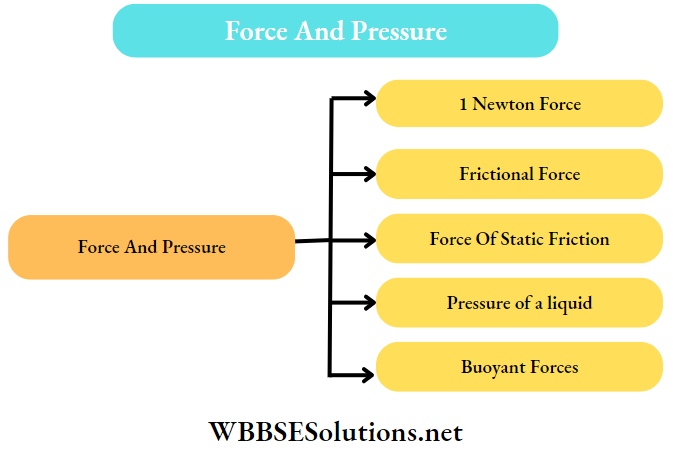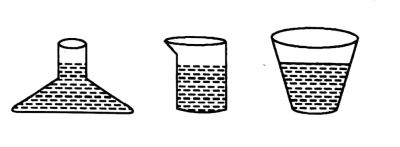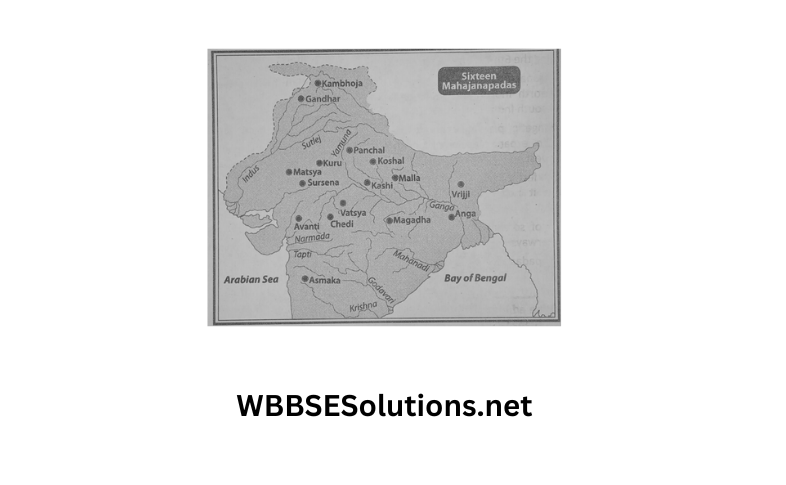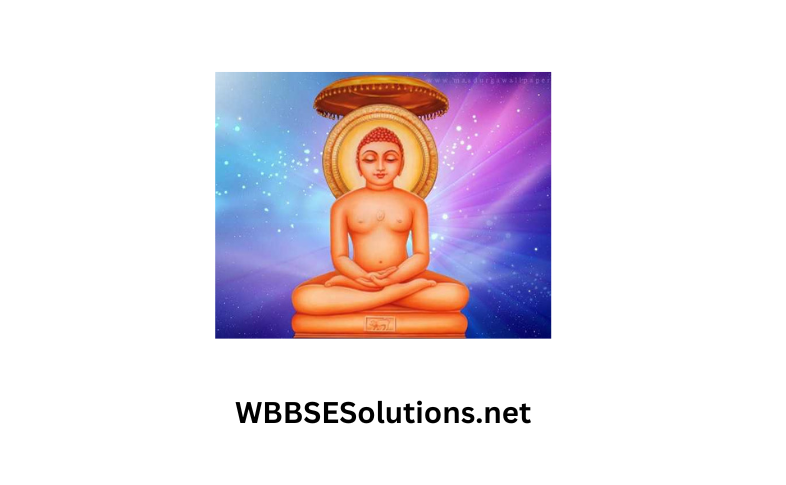Chapter 1 Physical Environment Force And Pressure Experiments On Liquid Pressure
Experiment-1
Two identical jars with a hole near the base (at the same depth) are taken. The hole is initially sealed with a cork or with molten wax.
One of the jars is filled with water up to a certain height, and the other is filled with concentrated saline water up to the same height.
As the holes in both the bottles are opened, liquids immediately start coming out through the holes in the jets.
Observation: It is found that of the two liquids, the range (i.e., the distance a liquid travels when coming out of the hole in the jet) of the concentrated saline water is longer than that for the ordinary water.
Also, the concentrated saline water exerts a pushing force on fingertips (if we place a finger on the hole to stop the liquid flow) which is more than that in the case of ordinary water.
Read And Learn More WBBSE Solutions For Class 8 School Science Experiments Questions
Chapter 1 Force And Pressure Experiments On Liquid Pressure
Experiment-1 On Liquid Pressure
Two identical jars with a hole near the base (at the same depth) are taken. The hole is initially sealed with a cork or with molten wax.
One of the jars is filled with water up to a certain height, and the other is filled with concentrated saline water up to the same height.
As the holes in both the bottles are opened, liquids immediately start coming out through the holes in the jets.
Science Experiments For Class 8 WBBSE
Observation: It is found that of the two liquids, the range (i.e., the distance a liquid travels when coming out of the hole in the jet) of the concentrated saline water is longer than that for the ordinary water.
Also, the concentrated saline water exerts a pushing force on fingertips (if we place a finger on the hole to stop the liquid flow) which is more than that in the case of ordinary water.
WBBSE Class 8 Force and Pressure experiments
Inference: The height of the liquid level in both jars is the same. But concentrated saline water has a higher density than water and a liquid with higher density exerts more lateral pressure.
The more the lateral pressure, the longer the distance the water travels when coming out of the holes in jets. So, we can infer that lateral pressure at any point within the liquid depends on the density of the liquid.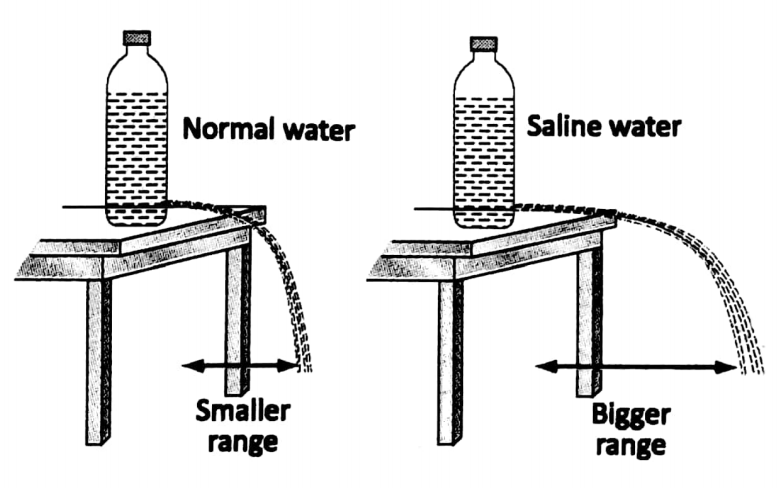
Chapter 1 Force And Pressure Experiment-2 On Liquid Pressure
A long jar with three outlets A, B, and C along its length is taken. The three outlets are closed with corks or with molten wax.
The jar is now filled with water or any other liquid. The three openings are then opened simultaneously. Liquid flows out through all the holes in the jets.
Science Experiments For Class 8 WBBSE
Observation: It is found that of the three liquid jets, the range of the lowest one is the longest as well as the strongest. As we go up, the range (i.e. the distance covered by the liquid jet) decreases.
Inference: Liquid is coming out from all three holes. This means the liquid exerts lateral pressure on the wall of the jar. The lateral pressure at any point within a liquid increases with the depth from the free surface of the liquid.
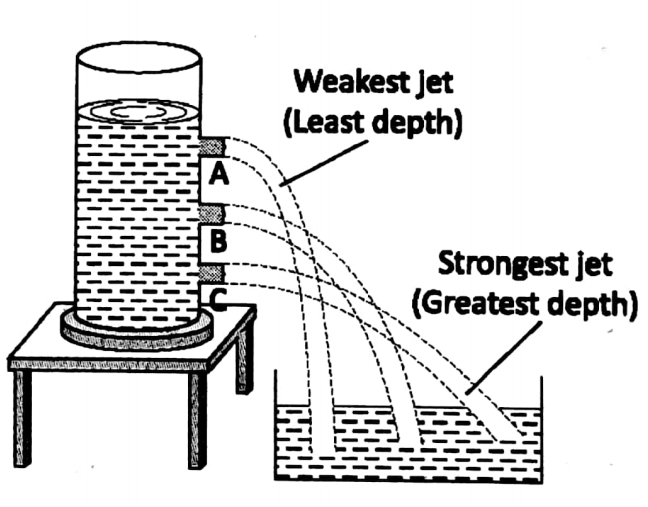
Chapter 1 Force And Pressure Experiment-3 On Liquid Pressure
Experiments on force and pressure for Class 8
Apparatus needed: A glass funnel with its mouth closed with a thin rubber sheet, a rubber tube, a glass tube that contains a drop of colored liquid, a scale, a beaker, and some liquid.
A glass funnel with its mouth closed with a thin rubber sheet is taken. A rubber tube is attached at the end of the stem of the funnel.
The other end of the rubber tube is connected to a glass tube that contains a drop of colored liquid (index). The glass tube is fixed horizontally on a stand.
Science Experiments For Class 8 WBBSE
A scale is also attached alongside the glass tube. Some liquid is taken in a beaker. The glass funnel (attached to the rubber tube) is immersed in the liquid and at a certain depth from the free surface of the liquid, the mouth of the funnel is made to face in different directions
Observation: The colored liquid drop in the horizontal glass tube remains at the same position, irrespective of the direction of the glass funnel immersed within the liquid (sideways or lateral, upward, downward, etc).
Inference: No change in the position of the liquid drop within the horizontal glass tube indicates that the pressure exerted by the liquid at a certain depth is equal in all directions.
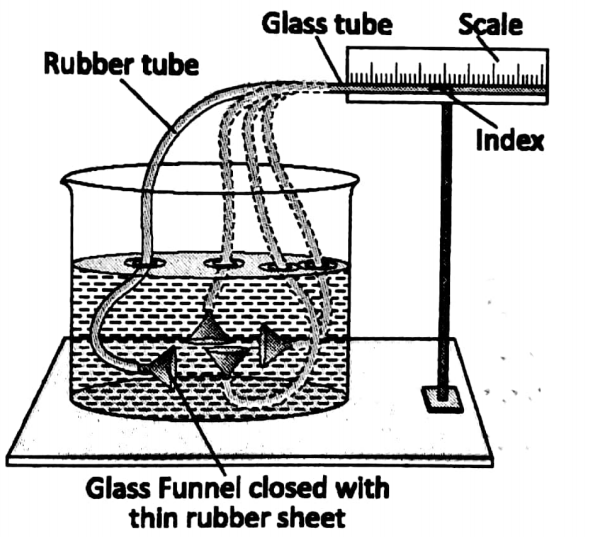
- Pressure at a point inside a liquid depends on the density of the liquid [Experiment 1].
- Pressure at a point within a liquid increases with depth [Experiment 2].
- So long as the depth remains the same, the pressure exerted by a liquid is the same in any direction. In other words, liquid exerts pressure evenly in all directions at a given depth [Experiment 3].
Some more experiments can be carried out to understand other properties related to the All these observations can be summarized as the pressure of a liquid. follows:
Chapter 1 Force And Pressure Experiment-4 On Liquid Pressure
A “U”-shaped glass tube is taken. The right-hand side of the glass tube has a larger radius compared to that of the left-hand side of the tube. Initially, the connecting pipe is closed by a stopcock.
Let the same liquid is taken in both tubes and both of them be filled in such a way that the liquid level in the right-hand tube is lower than the liquid level in the left-hand tube.
Because of its bigger cross-sectional area, the right-hand tube contains more volume of liquid than the left-hand tube.
Science Experiments For Class 8 WBBSE
The stop cock at the connecting side to the right-hand side; indicates that the pressure pipe is then opened
Observation: It is found that the liquid is moving from the left-hand side to the right-hand side. As a result, the liquid level on the left-hand side gradually decreases and the liquid level on the right-hand side gradually increases. This will continue till the liquid levels at both sides become the same.
Inference: The flow of liquid takes place from a region of higher pressure to a region of lower pressure.
Since the liquid is flowing from the left-hand side to the right-hand side; it indicates that pressure is higher at the base of the left-hand tube than at the base of the right-hand tube.
The volume of liquid in the right-hand tube was more but the initial height of the liquid column was less compared to that of the left-hand tube.
This clearly illustrates that pressure exerted by a liquid at any point within it is independent of the volume (or mass) of the liquid but depends only on the height of the liquid from its surface to that point.
So we can conclude that the Pressure, and not the force, decide the direction of the flow of a liquid.
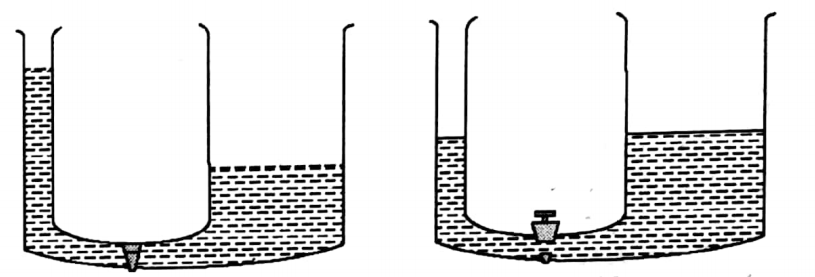
Understanding force and pressure experiments Class 8
Chapter 1 Force And Pressure Experiment-5 On Liquid Pressure
An Apparatus, apparatus consists of five glass tubes of various shapes, and they are connected to each other by a horizontal glass tube.
The apparatus is placed on a table vertically and water ( or any other liquid) is gradually Poured through any of the tubes.
Observation: It is found that the level seeks its level, and rises up through the pipes fitted in each building. the liquid in all the tubes is the same.
Science Experiments For Class 8 With Explanation WBBSE
Inference: This experiment clearly illustrates that liquids seek their own level.
This fact is utilized in supplying water in a locality. The municipal storage tank is made at a level higher than the height of the buildings in the locality.
Since we know that liquids seek their own level, the water flowing out from the storage tank through the water supply pipes also In domestic buildings, the water reservoir is placed on the rooftop.
Water flows down from the reservoir through the pipes connected to taps on different floors. When the taps are opened, water gushes out because the water in the taps tends to come to the same level of water kept in the reservoir.
This tendency is due to the property of a liquid that a liquid finds its own level.
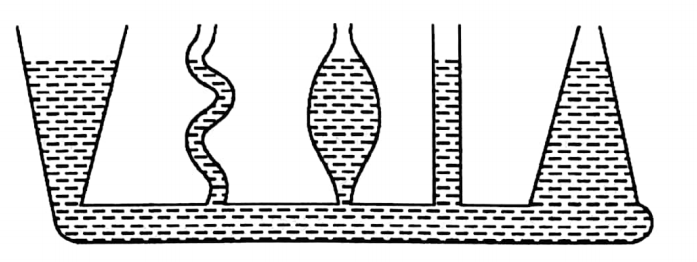
Application of these Observations
In domestic buildings, the water reservoir is placed on the rooftop. Water flows down from the reservoir through the pipes connected to taps on different floors.
When the taps are opened, water gushes out because the water in the taps tends to come to the same level of water kept in the reservoir.
This tendency is due to the property of a liquid that a liquid finds its own level. Submarines are forbidden to sink beyond a limit in the sea.
As the depth increases, the pressure exerted by the liquid on the submarine increases. If a submarine sinks below a certain depth in the sea, the tremendous pressure of the seawater may crush its body.
The lower part of a dam is made thicker than its upper part. The reason behind this is that the lower part of the dam is at a greater depth in water.
Science Experiments For Class 8 With Explanation WBBSE
As we know that the pressure of the liquid increases with depth, so the pressure of water is very high at the lower part of the dam compared to its upper part.
To withstand the enormous pressure of water, the lower part of the dam is made thick and strong.
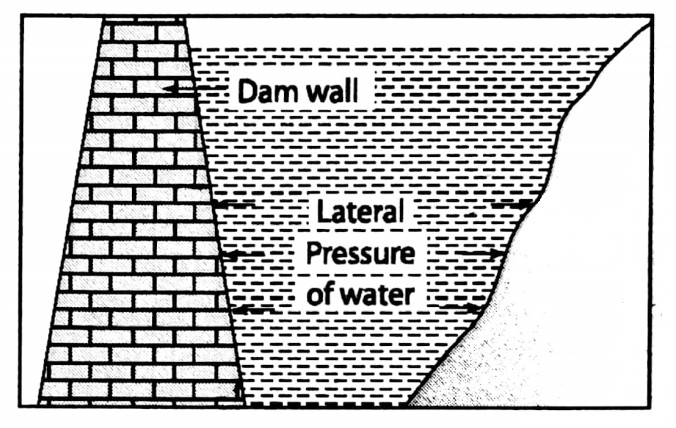
WBBSE Chapter 1 practical activities on force
Air Pressure
We have just discussed the pressure at any point within a liquid. But is the pressure at that point due only to the pressure exerted by the liquid at that point?
Certainly, the answer is ‘no’ since we are surrounded on all sides by the Experiment atmosphere which has a certain weight and hence, it also exerts pressure.
Thus, air also exerts pressure on the surface of the liquid. This can be illustrated with the help of an experiment.
Chapter 1 Force And Pressure Air Pressure Experiment On Liquid Pressure
A tumbler, filled with water is taken. A glass tube, approximately 2-3 feet long with both ends open, is completely filled with water and both its ends are shut tightly with thumbs so that no water can escape.
Science Experiments For Class 8 With Explanation WBBSE
Then one end of the water-filled tube is dipped vertically in water taken in the tumbler and the thumb is removed from that end of the tube keeping the other end shut my thumb.
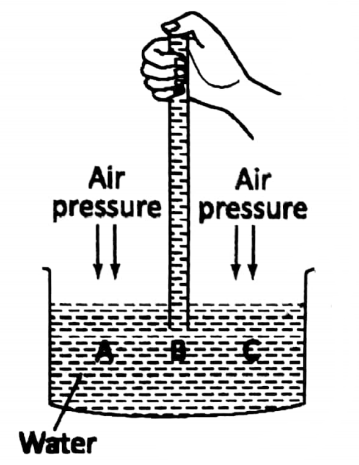
Observation: It is found that water does not flow out from the glass tube to the tumbler.
Inference: Let us consider three points A, B, and C, situated at the same plane inside the water. Point “B” is situated exactly beneath the glass tube filled with water.
We know that the pressure at a point inside a liquid increases with depth. Since the height of the water above point “B” is more than that at “A” and “C”, so we expect that the pressure of water at “B” is more than that at “A”> and “C”, and water should flow from B to A and B to C.
But actually, water does not flow out from B towards A or C. This is because the pressure at A and C is not only due to the pressure of the liquid but also due to the pressure of the air on the surface of the liquid above A and C.
So the pressure at A and C is not less than that at B. That is why water does not flow from B to A or from B to C.
If the thumb at the other end is now removed from the top of the glass tube, water will flow out of the tube.
This is because as soon as the thumb is removed, air exerts pressure on the surface of the water taken in the tube.
Then pressure at B becomes more (being the sum of the air pressure and the pressure exerted by the water column of the tube) and the water flows out from the tube to the tumbler.
Let us now carry out the same experiment with a glass tube of length of approximately 12 meters, whose one of the ends is sealed.
The tube is filled with water and if its open end is carefully immersed in a water-filled tumbler in a vertical manner, we will find that the water will come out from the tube.
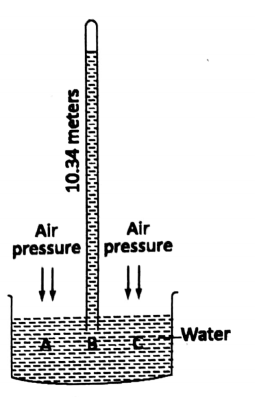
The water level within it will gradually decrease till the water level in the tube is 10.34 meters from the surface of the water in the tumbler.
The fact is that when the water level within the glass tube is approximately 12 meters, water pressure within the glass tube at point “B” is more than the pressure of the air exerted on the surface of the liquid (at either point A or C).
But the pressure exerted by a 10.34 meter-long water column on “B” is the same as the pressure exerted by the air on the surface of the water (at either point A or C).
Force and pressure science experiments for Class 8
Liquid Pressure Experiment WBBSE
Thus, atmospheric pressure or air pressure (due to the enormous weight of air layers that constitute the atmosphere) is equivalent to the pressure exerted by a water column of height 10.34 meters.
If we imagine a unit area of the earth’s surface and a very tall column filled with air (up to the extremities of the atmosphere) standing on it, then the weight of air in this column will be the atmospheric pressure at that place.
On the surface of the earth, the atmospheric pressure is maximum at sea level.
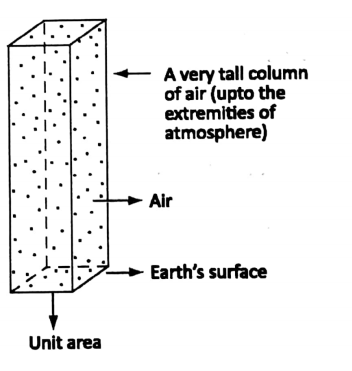
This is because the column of air above us is tallest at sea level. The atmospheric pressure at mean sea level is taken as standard and its value is 101.3-kilo pascals (1 pascal = 100 N/m²).
Since the weight of the air constitutes the atmospheric pressure, so as we go up in the atmosphere from the surface of the earth, the atmospheric pressure goes on decreasing.
This is because as we go up in the atmosphere, the weight of air above us goes on decreasing due to which the pressure also goes on decreasing.
So, the atmospheric pressure at the top of a high mountain will be much less than at its base. Just as the pressure in a liquid acts in all directions, in the Thumb same way, atmospheric pressure also acts in all directions.
Evangelista Torricelli (1608 1647), who succeeded Galileo as Professor of Mathematics at the Academia in Florence, developed a method for measuring the pressure exerted by air (which is called atmospheric pressure) by using a similar experiment with mercury instead of water.
Liquid Pressure Experiment WBBSE
He used a long glass tube of approximately 100 cm in length (closed at one end) filled with mercury and then it was inverted in a bowl containing mercury.
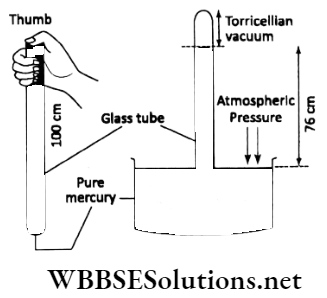
He found that some mercury moved down thereby creating an empty space at the sealed top end of the tube, which is commonly called a Torricellian vacuum. It is found that at sea level, the pressure exerted by a vertical column of mercury of height 76 cm is equal to the pressure of the air exerted on the surface of the mercury in the bowl.
class 8 science chapter 10 WBBSE
Hence, atmospheric pressure is expressed in terms of the height of the mercury column and normal atmospheric It is also found that pressure is equal to the pressure of a 76cm high mercury column.
This simple arrangement is known as Torricellian Barometer. It may be noted that the instrument used for measuring air or atmospheric pressure is known as Barometer.
- The vertical height of the mercury column is independent of the size and shape of the tube.
- The vertical height of the mercury column is not changed even if the tube is tilted.
Fortin’s Barometer, an improved version of the Torricellian method, is the instrument employed to measure the atmospheric pressure at a place.
It uses mercury following the Torricellian principle. Water is not used in the barometer. This is because water is less dense than mercury (The density of mercury is 13.6 gm/cc and that of water is 1gm/cc).
The normal atmospheric pressure is equal to the pressure of a 76cm high mercury column. This simple arrangement is known as Torricellian Barometer.
Liquid Pressure Experiment WBBSE
It may be noted that the instrument used for measuring air or atmospheric pressure is known as Barometer.
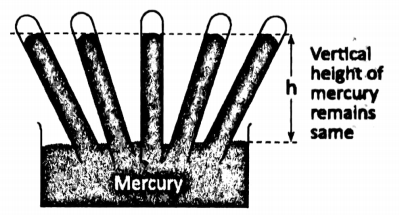
Practical examples of force and pressure for Class 8
pressure can support 10.34 meters of water as against 76cm or 0.76m of mercury column. If water is used in a barometer, we need a tube of a length of more than 10.34 m. Using such a long glass tube is not practicable.
Buoyancy and Immersion
It is our common experience that a piece of wood floats on water, an iron nail immerses but a ship made of iron floats in water.
In this section, pressure can support 10.34 meters of water as against 76cm or 0.76m of mercury column.
class 8 science chapter 10 WBBSE
If water is used in a barometer, we need a tube of a length of more than 10.34 m. Using such a long glass tube is not practicable.
let us discuss some aspects of immersion or floating of any object on liquid. Let us perform an experiment to prove that a solid weighs less in water and more in air.
Chapter 1 Force And Pressure Buoyancy And Immersion Experiment-1
A heavy, solid object is taken which will immerse completely in water when dropped freely. Let this object be hung from a spring balance.
The weight of the object is determined from the reading on the spring balance. Then the same object is partially immersed in water, the object is still tied to the Pointer- the spring balance.
The reading on the spring balance shows a decrease in the weight of the object. When the same object is completely immersed in the water, the weight shows a further reduction.
It is evident that the solid weighs less in water than in air. It seems that some invisible force acts in the upward direction when a body is immersed in a liquid.
This force is responsible for making the weight of the object less than its weight in the air.
So the object suffered a loss of weight when immersed in a liquid – either partially or completely.
partially or completely, it experiences an upward When an object is immersed in a liquid, a force called “buoyant force”.
When the object is immersed in a liquid, it displaces some volume of liquid and occupies that position.
Liquid Pressure Experiment WBBSE
The weight of the displaced liquid is equal to the magnitude of this upward force or buoyant force.
This buoyant force is responsible for the decrease in the weight of the object when it is immersed in a liquid.
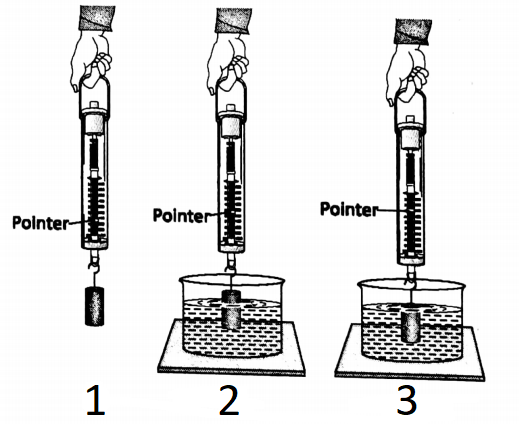
Archimedes’ Principle
Approximately two thousand years ago, famous Greek philosopher and scientist Archimedes proposed the relation between the apparent loss of weight of an object when immersed in liquid and the weight of the liquid displaced due to immersion of the object.
This relation is known as Archimedes’ Principle. When a solid object is immersed in a liquid (partially or completely), it experiences an upward buoyant force, which is equal to the weight of the liquid displaced by the immersed -part of the object.
From the Experiment stated above we can also conclude that buoyant force is directly proportional to the volume of liquid displaced by the solid object.
When the object is completely immersed in water the weight loss is more because it displaces more water compared to when it is partially immersed.
class 8 science chapter 10 WBBSE
Accordingly, the weight loss due to buoyant force is more in the case of complete immersion of the object in the water.
If the same object is now immersed completely in two different liquids having different densities, it is found that the weight loss is more in the case of liquid with higher density.
This is due to the fact that though the volume of liquid displaced by the object is the same in both cases, the mass of liquid displaced is more for the liquid Buoyancy is therefore absent in a vacuum since there is no medium to displace in a vacuum.
Principle, the buoyant force is more, which is evident from the higher weight loss in liquid with higher density.
For example, a piece of iron that sinks in water can float in mercury. Hence, we can summarize these observations as follows:
When a body is immersed in a liquid either completely or partly, it always experiences a buoyant force or upthrust.
The buoyant force is directly proportional to the volume of liquid displaced by the solid object. The buoyant force is directly proportional to the density of liquid displaced by the solid object.
When a body floats in a liquid, the weight of the whole body acting vertically downward is completely balanced by the buoyant force produced by the displaced liquid.
The weight of a body immersed in a liquid is always less than its actual weight because of buoyancy or upthrust.
This weight of the body in the immersed condition is called the apparent weight which is always less than the true weight of the body.
Let us perform an experiment similar to that with higher density. So according to Archimedes shown earlier to verify Archimedes’ Principle.
Chapter 1 Force And Pressure Archimedes’ Principle Experiment 2
This experiment aims to establish the relationship between the loss in weight of a solid and the weight of water displaced by it when the solid is fully immersed in water.
Take a jar and a beaker placed under the spout of the jar. Pour water into the jar up to the level of the spout.
Suspend a heavy solid by a thread from the hook of a spring balance and the weight of the solid in the air is measured. This is the true weight of the solid.
Now the solid is carefully lowered into the jar and its new weight is measured when it is completely immersed in water. This is the apparent weight of the solid.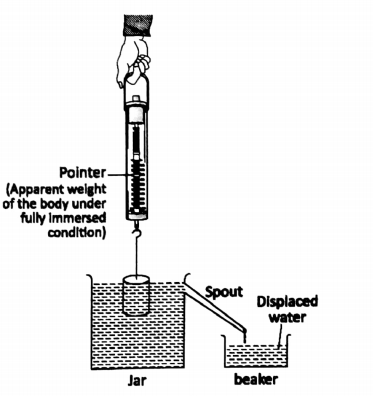
The displaced water is collected in the beaker and its weight is measured. It will be found that,
(True weight of the solid in the air) –
(Apparent weight of the solid in water) = Weight of the displaced water.
Loss in weight of the body
= Weight of displaced water
= Upward Buoyant force Thus, Archimedes’ Principle is verified.
Liquid Pressure Experiment WBBSE
1. So we have realized that when immersed in water or any liquid, a body experiences an upward force due to buoyancy which acts against the direction of the weight of the body.
If the weight of the body is more than the buoyant force, the body sinks into the liquid. For example, an iron nail sinks in water.
2. But if the buoyant force (acting upwards) is more than the weight of the body (acting downwards), then the body floats in the liquid (with a part of it immersed in the liquid).
For example, a piece of wax floats in water. If the weight of the body is equal to the buoyant force, then the body floats somewhere within the liquid.
For example, a drop of olive oil floats anywhere within a mixture of an equal volume of water and alcohol.
3. Although animals like buffaloes, cows, etc. are ignorant of swimming techniques, yet they can swim with ease.
This is because their voluminous bodies displace a huge quantity of water that produces a large buoyant force which is more than their body weight. Hence, they remain floating in the water.
4. When a person swims in water, he/she has to move his/her hands and legs properly to displace a large volume of water whose weight must be greater than his/her body weight.
Only then he/she can remain floating on the water. Moreover, the human head is heavier than any other part of the body. So a swimmer tries to keep his/her head above water while swimming.
5. A large and heavy log cannot be displaced when it is on land. But if it is in water, it can be shifted with a small effort.
Here, the log “loses” a part of its weight in water due to the buoyancy that the water exerts on the log. So the log becomes lighter in water and can be displaced with more ease.
6. Ice floats in water. When water is converted into solid ice, the arrangement of molecules inside it becomes such that its volume increases. As a result, the density of ice becomes less than the density of water.
So, when a piece of ice is immersed in water, it floats, because the weight of water displaced by its immersed part is more than the weight of the ice.
So, buoyant forces prevail, and the piece of ice floats in the water. In ordinary water, 11/12th part of the volume of ice remains submerged. of iron floats in water. This is because the ship
WBBSE Chapter 1 experiments with explanations
7. An iron nail sinks in water, but a ship made displaces a huge quantity of water due to the bulged shape of its lower part.
The upward buoyant force which is equal to the weight of this displaced water is sufficient to balance the weight of the entire ship.
So the ship floats. But an iron nail can displace a very little volume of water which is insufficient to produce enough buoyant force to make it float on the water.
8. An egg sinks in ordinary water but floats displaced by the egg in water that is less than its own in concentrated saline water. The weight of water weight. So it sinks into ordinary water.
Liquid Pressure Experiment WBBSE
But when it is immersed in concentrated saline water (whose density is more than that of ordinary water), then the weight of the displaced water is more than the weight of the egg.
So the egg floats. If the salted water is diluted, the egg will sink again. Jordan has such a high salt content that a person
9. Water of the ‘Dead Sea’, situated near may lie leisurely on the water. The high salt content in water produces such a large buoyant force that a person may easily float on it. seawater. This is because the density of seawater
1. A ship sinks deeper in river water than in is more than the density of river water, due to dissolved salts in seawater.
When a ship enters density to a liquid of lower density, a greater volume of the river from the sea, i.e. from a liquid of higher water has to be displaced to produce sufficient buoyant force so that it can float.
So the ship sinks deeper into the river water. going down water, when necessary.
10. A Submarine is a small warship capable of Submarine can sink by changing the buoyancy on it by letting water into ballast tanks. A ballast tank is a large, hollow steel box within the submarine.
When the ballast tank is filled with water, the weight of the submarine is increased and it is more than the weight of water displaced by the submarine.
So, the submarine sinks. When the ballast tank is made empty by pumping out the water from it, the total weight of the submarine decreases, and this is less than the weight of water displaced by it. So it floats on water.
